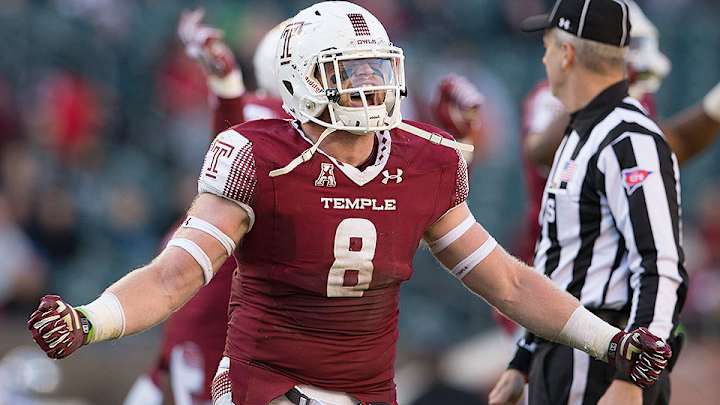The Case For ... underrated Temple LB Tyler Matakevich

“Children should be neither seen nor heard.” That’s the credo of the fictitious Milford Academy, a school some Bluth family members attended on Arrested Development.
Tyler Matakevich’s year spent at the actual Milford (N.Y.) Academy no doubt was far less repressive, but that quote does sort of sum up his journey to the cusp of the NFL.
Matakevich received zero scholarship offers despite helping lead his St. Joseph High School team to back-to-back Connecticut state championships. Temple then was one of a small handful of programs that showed any extended interest in him after his stop at Milford. At the time, the Owls were in the midst of a transition from the Mid-American Conference to the Big East, with another move to the AAC on the horizon. They just had snapped out of a dismal stretch that saw them go without a winning record from 1991 to ’08.
• BURKE: Three-round mock draft | Draft needs for all 32 teams
With no other options on the table, Matakevich signed anyway. Four years later, the Owls posted their first 10-win season in almost three decades, and Matakevich took home the Bednarik Award for the nation’s best defensive player and the Nagurski Award for the nation’s top linebacker with a brilliant 138-tackle senior season.
“I definitely just think I got overlooked,” Matakevich said at the combine of his quiet recruiting process. “I’m grateful Temple gave me an opportunity.”
His goal now: Convince an NFL team to do the same.
• The Case For ... Dean Lowry | D.J. Foster | Kevin Peterson | Kevin Hogan
It will happen. Matakevich simply was too good for Temple to not hear his name called somewhere on draft weekend, likely during Rounds 4–7 on its third day. He is an unusual fit for an NFL linebacker, built more like a fullback (6' 0", 238 lbs.) and without any standout athletic traits; his 4.81-second 40, 31-inch vertical and 7.19-second three cone are all middle-of-the-road combine marks among his position group.
He is quick to point out that he produced in college despite his physical limitations. And he credits his time spent working off the field for that success.
“There’s nothing I can do about my size. It’s the film. I think I put enough [on] film for the past four years for them to see that my size doesn’t matter,” Matakevich said. “I understand I’m not the biggest, the strongest, the fastest, but I’ll beat you in the film room. ... I think that’s what makes me such a special player and that’s what is going to allow me to get to the next level.”
Oral history of the 1971 NFL draft: The original Year of the Quarterback
By his own account, Matakevich put in an extra two to three hours of film work per day, on top of his team requirements. That attention to detail stands out when Matakevich is in action. He routinely is among the first defenders to the ball, displaying outstanding recognition against both the run and pass. On top of his tackle numbers, Matakevich also set career highs as a senior with 4.5 sacks, five interceptions and five pass breakups.
His general lack of quickness could prevent him from seeing the field much on passing downs, at least as an NFL rookie. It should be much more difficult to keep him on the sidelines against run formations. Matakevich’s obvious fit is as an inside or middle linebacker in a 4–3 or 3–4 scheme, though Lance Zierlein of NFL.com also tossed out the idea of using him as a 4–3 WILL.
“Most teams are talking about being in the middle,” Matakevich said. “Definitely, when I’m in the box, I feel like that’s when I’m in my element. I see more than your average person can see when I’m in the box.”
This is a prime example of where the NFL draft scouting process can become a tad murky. If a player doesn’t test well or fit a positional prototype but dominates at the college level, how does a front office balance everything? There are noteworthy examples of guys bucking the trends. Russell Wilson is the go-to example at QB; Chris Borland is perhaps a more appropriate reference for someone like Matakevich.
A prospect can be “gritty” or a “winner,” but what’s that mean for his evaluation?
“It just goes to remind me—talent isn’t the right word. But talent is almost intangible,” Temple coach Matt Rhule told Philly.com. “The ability to play football is intangible. You couldn’t measure it, you couldn't identify it on a chart. But whatever it is, [Matakevich] has it.”
We’re treading dangerously close to “Is Joe Flacco elite?” waters here. But the truth is that Matakevich is a better football player than the numbers tell us he should be. While those same numbers may limit his draft ceiling, there are worse players to take a chance on than an overachiever with tremendous on-field awareness.
Like a quarterback who can read defenses pre-snap, linebackers with the football intellect to diagnose plays and get to their spots are coveted. Matakevich, without question, has that in his repertoire.
The All-22: Watching tape with UCLA LB Myles Jack
“There’s things that come natural, but my preparation, it’s a lot of hard work and I put in a lot of hard work to study my opponent,” Matakevich said, “and that’s what makes me able to make the plays I’m able to make.
“I can see a team come out in 11 personnel and narrow it down to a few plays. Then, once I see a key, I’m beating the ball to where it’s going to be. That just comes with a lot of time in the film room.”
Is all that enough to land him an NFL shot? It should be.
